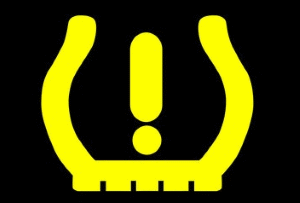The air in your tyres is affected by temperature. When it’s warm, the pressure is higher and when it’s cooler the pressure is lower. The tyres aren’t what supports the weight of your car, it’s the air in the tyres, and it’s usually kept at a pressure of around 32 PSI, or pounds per square inch. Yes, we moved to the metric system years ago, but some measures will stay forever imperial. However, you might occasionally see kPa for kilopascals.
Things that influence your tyre pressure are:
- Ambient temperature, i.e. what is the air temperature outside the tyre
- Tyre temperature
- Sun exposure
- Leakage, i.e. puncture or natural leakage)
Vehicle manufacturers make a recommendation for tyre pressures which usually is displayed on a plate riveted to the B pillar (the one you’ll see if you open the front doors). This pressure is related to the type and size of tyre and the weight of the vehicle and is called the cold inflation pressure because it is the pressure to use when inflating the tyres when cold.
During use and even throughout the course of the day, tyre pressure varies.
Change in tyre pressure due to ambient temperature changes
Cold weather means less tyre pressure than hot weather. Lower pressures increase the amount of tyre in contact with the road which increases fuel consumption. Lower pressure makes the sidewalls of the tyres more flexible and compromises grip and handling. It also means that the tyre deforms more due to the weight of the vehicle and this causes heat buildup in the rubber, reducing its life.
For every decrease of 1 degree Celsius the tyre pressure drops by approximately 0.19 PSI.
The temperature record high in Sydney is 45.8 degrees Celsius. Typically, though, the daily temperature might fluctuate 10-15 degrees, perhaps 20 degrees maximum. If you fill your tyres when the outside temperature is 27 degrees, then take your vehicle out when it’s 7 degrees at night, your tyre pressure will have dropped significantly – by 3.8 PSI.
Change in tyre pressure while driving
As the tyres deform on the road as they turn, it creates resistance and some of this is turned into heat. This causes the air in the tyres to expand and it increases the pressure by about 1 PSI for every five minutes up to a maximum of between 4-5 PSI. It’s best to check and adjust your tyre pressures after the vehicle has been sitting a couple of hours. Wet weather can mitigate this somewhat as driving through water dissipates the heat.
Change in tyre pressure due to direct sun exposure
The sun’s influence on tyre pressure can make up to 15% difference. Those black tyres in the hot NSW sun absorb the heat, passing it on to the air inside.
Automatic tyre pressure monitoring systems
Looking at the different calculations above it’s possible to have a variation of 10 PSI. If you fill your car tyres while they are cold on a cold night then you drive it on rough, dry roads at high speeds in the blazing sun you are adding much more pressure.
Many cars comes with a tyre pressure monitoring system which displays a light on the dashboard if tyre pressures are outside a predefined range.

How do you reduce the effect of temperature change on tyre pressure?
First, check the pressure of your tyres (including your spare tyre or space saver) every month and you will then be able to normalise them for the temperature. You could also fill your tyres with nitrogen rather than air as this is less likely to leak out through the rubber and isn’t affected as much by temperature.
This article explains how to calculate tyre pressures.
